Purim is this coming Saturday night March 19th. The traditional reading of the Megilat Esther, The story of Esther will be read amongst Carnival type revelers in costumes with much merriment and consumption of adult beverages. On Purim it is traditional to give out Purim Platicos or Mishloach Manot on the day after the first reading of the story. Since Jewish holidays start at sundown on the evening before, the daytime celebration comes after. On that day, I make myself a logistics map and drive around for a few hours to drop off all of the Platicos or goodie baskets. Later that day we sit down to a Purim Seudah or Purim feast.
After the feast we enjoy dessert from all of the things I baked to fill the Platicos. This year I baked, Hamantashen, Oatmeal Cookies, Pistachio Biscotti, Brownie Cakes, mini Banana Breads, and I tried my hand at Masapan. To find the recipes for the Hamantashen and other things just click on the word and it should take you there. Masapan will be posted tomorrow.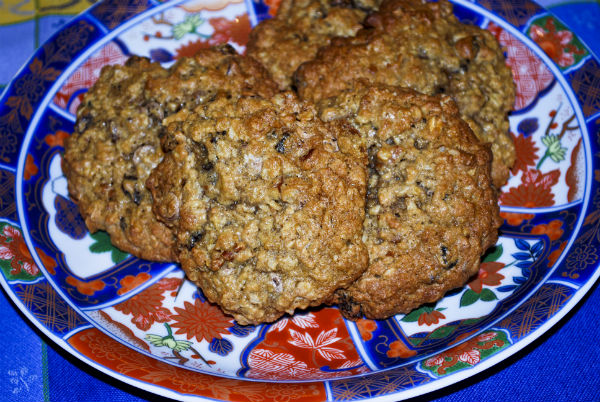

In the meantime my sister Carole, who recently visited, said that when she was a little girl, Papu (grandfather) Behor Chiprut taught her how to make Turkish coffee. Papu was from Turkey and he wanted to be served his coffee or Kahve every day. Make some Kahve, grab some biscotti, and enjoy Purim.
Carole’s Turkish Coffee
#6 Ibrik or Turkish Coffee Pot
6 demitasse coffee cups and saucers
6 mounded teaspoons Venizelos ground espresso coffee in a can
6 teaspoons of sugar
cold water
Place the coffee and sugar in the coffee pot. Add 6 partially full demitasses of cold water. Stir. Bring the water and coffee to a boil slowly. The moment it comes to a boil turn off the heat or remove it from the heat. When the foam subsides, bring to coffee to a boil a second time, remove the coffee pot from the heat and add 1 tablespoon of cold water. Let the coffee rest for a couple of moments as the grounds settle.
 Next, pour the coffee into the demitasse cups and include a bit of the foam on top of each one. Sip your coffee slowly until you are down to the grounds. Turn your cup over for a couple of seconds, then when you right the cup the grounds will have left a pattern inside the cup. A skilled fortune teller can read the pattern of your grounds.
Next, pour the coffee into the demitasse cups and include a bit of the foam on top of each one. Sip your coffee slowly until you are down to the grounds. Turn your cup over for a couple of seconds, then when you right the cup the grounds will have left a pattern inside the cup. A skilled fortune teller can read the pattern of your grounds.
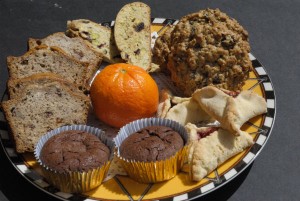
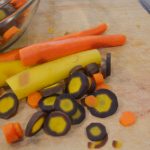
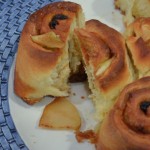
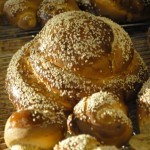
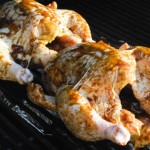
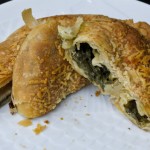

Linda, everything you made looks so good, as always. Those who are going to receive your baskets are very lucky! Looking forward to the masapan recipe.
I agree completely with Megi. Your photos (both of the food and the displays either on tables or in baskets, not to mention those beautiful demitasse cups and the ibrik) are always so beautiful, so enticing and appealing…and of course, delicious!
Thank you, as always, for sharing all your recipes – especially the holiday-inspired ones, like this one. Absolutely beautiful, Linda.
To you, your family and all the people who read and love your blog: Chag Purim Sameach!
Hi Linda,
I can’t say it any better than Megi and Greek girl. Everything is presented with such beauty–each post is a treasure to us. You are doing a wonderful job of preserving a heritage, recipe by recipe.
I have benefited so much from your blog. Your recipes are accurate and delicious. Just last night my family enjoyed both oven roasted cauliflower and carrots. Looking forward to the new cauliflower and plantain recipe you said will be posted soon.
Wishing you, your family and all the readers of your blog a very Happy and Healthy Purim!!!
Norma, you truly moved and touched me when I read your most beautiful sentiment: ‘…You are doing a wonderful job of preserving a heritage, recipe by recipe.’ I agree with you completely – Linda’s blog is a joy to read and I always look forward to reading about new recipes, their historical and cultural background, as well as Linda’s own personal connection with the recipes.
What you’d written, though, about Linda helping to preserve our Sephardic heritage, really evoked something deep within me. Fond and vivid memories from my childhood, helping my Nuna make (forgive me, but you know where I’m going with this) bee-yee-koos (aka boyokos, aka borekas) and ‘kloothya’ (aka ‘koulourakia’), and my Papu coming back from South America (he was a fruit and veggie importer) with all these amazing and colourful fruits and veggies for us to try, and all my aunts, uncles and cousins all having big family dinners and the singing and dancing and laughing and chatting afterwards…such wonderful memories. That’s what this blog evokes in me with pretty much east blog post you offer and share with us, Linda.
So, as Norma quite beautifully and perfectly expressed, thank you for helping me not only preserve, but remember my beautiful Sephardic heritage, one recipe at a time, and one beautiful blog post (with equally beautiful photos) at a time.
ps – Happy Day-After-St.-Patrick’s Day to you all!